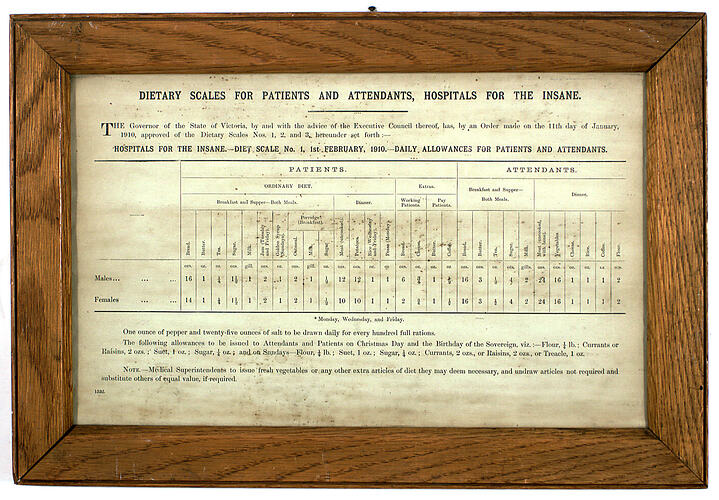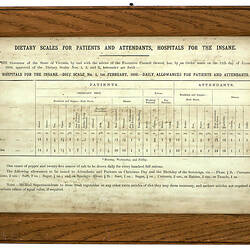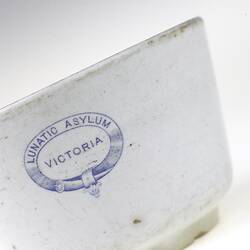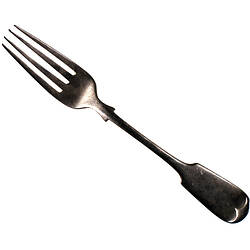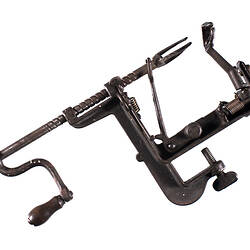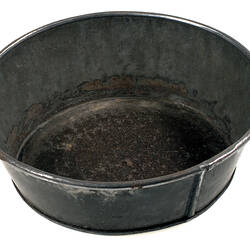Summary
An account of the dietry food and nutrition provided for patients in psychiatric hospitals in Victoria Australia from 1900 to the end of the 1970s.
Dr Paul Ward Farmer published an account of his three-week confinement to the Kew Asylum. He remarked that, 'The coffee was a tasteless fluid, resembling the usual decoction only in colour and the vegetables were of a very coarse rough nature' (Farmer, 1900, p.21). While Farmer found the coffee distasteful, most patients were in no position to judge, coffee being an 'extra' granted only to 'pay patients'. It was one of only two such extras allowed, the other being an additional ounce of butter per patient.
Most patients subsisted on a monotonous diet of bread and butter and tea, served at both breakfast and dinner, with meat and potatoes for lunch - a diet little changed from that served a quarter of a century earlier (Report of the Inspector-General of the Insane 1905, p.25; Vagabond, 1877, pp.106-10).
Six years after Farmer's complaints, the head of the Lunacy Department, Dr W. Ernest Jones, wrote at length about the shortcomings of the patients' diet, noting the 'eternal monotony of bread and butter with tea', relieved only by a twice-weekly substitution of jam. A one-ounce allowance of 'plain boiled rice' three days a week was similarly the only variation to lunch, an addition that hardly seems likely to have enlivened the usual meat and potatoes. Pudding was served only twice a year, to celebrate Christmas Day and the King's Birthday (Report of the Inspector-General of the Insane 1905, pp.25-6).
Jones proposed a number of improvements to the patients diet which he argued 'would very materially add to their comfort and well-being' at little cost (Report of the Inspector-General of the Insane 1905, p.25). Two years later he reported that: 'Without in any way curtailing the existing diet scale, it has been found possible to provide at fairly low cost such simple necessities as porridge and soup daily, and puddings' (Report of the Inspector-General of the Insane 1907, p.32; see also Report of the Inspector-General of the Insane 1906, 29 and 1908, p.37).
The efforts of the Mental Hospital Auxiliaries, formed in 1933, also helped relieve the monotonous diet. Auxiliary volunteers provided patients with 'comforts' such as confectionary (Report of the Inspector-General of the Insane 1932, p.28) before later establishing kiosks that sold a broad range of foods to visitors, patients and staff.
The diet, however, was deficient in other ways. In 1936, the investigations of Dr John Cade established that it was not merely monotonous but nutritionally inadequate. Cade noticed a tendency among his patients to bruise unduly - a telltale sign that essential nutrients were lacking. When he surveyed the nutritional status of patients at the Beechworth and Mont Park Mental Hospitals, he found an unacceptable incidence of vitamin deficiency disorders. On investigating the quality and quantity of food and its method of preparation he concluded that the lengthy simmering used in mental health hospital kitchens destroyed essential nutrients. In the wake of his findings, the Department decided to employ a dietician for the first time in the eighty-eight year history of Victoria's mental hospital system (Report of the Director of Mental Hygiene 1937, p.17).
The deficiencies in the diet were not easily resolved. Ten years later, a 1948 report on mental health hospitals echoed earlier complaints. Tea, long one of the staples of the diet, was left to steep too long and the food often arrived cold from the kitchen, having been 'carried long distances in the open air regardless of the weather' (Mental Hospitals' Inquiry Committee, 1948, p.9).
Developments in food preparation and access to a broader range of foodstuffs revitalised meal options in mental health facilities over the following decades. By 1969 at Plenty Hospital, a composite menu was in use employing 'a fair proportion of convenient and prepared food stuffs' (Form re Plenty Hospital provided to Advisory Committee prior to its visit on 18 April 1972, p.1). In the same year, dietary standards at the Kew Cottages were rated at 'a good level and in some respects improved by the use of a wide range of foods including vegetables and other items in a prepared state' (Report of the Mental Health Authority 1969, p.77).
Food safety remained an issue with food poisoning blamed for two, or possibly three, patient deaths in Victorian mental health hospitals in 1972 and 1973 (Wilcox, 1974-76, pp.6847-8; Age, 1975). As a result, mental health authorities formed a dietary working party that evolved into a food services committee under the leadership of a dietician (Anon, June 1979, p.8). These bodies worked to upgrade catering standards in mental hospitals by establishing training courses for staff cooks and food service personnel, and by reviewing the suitability of foodstuffs purchased (Anon, July 1977, p.7).
Authors: Ann Westmore and Lee-Ann Monk
References
Age (1975), 'Deaths from Food Poisoning in Mental Hospitals', 1 October.
Anon (1977), 'Catering Course Planned', MHA Newsletter, vol. 3, no. 19, July, 7.
Anon, (1979) 'Miss Maren Lorentzen Senior Dietician', Mental Health Division Newsletter, vol. 5, no. 30, June, 8.
Farmer, Paul Ward (1900), Three Weeks in the Kew Lunatic Asylum, Melbourne, John J Halligan.
Form re Plenty Hospital provided to Advisory Committee prior to its visit on 18 April 1972, State Library Victoria Mental Health Auxiliaries Collection, MS PA 89/140, Box 3/13, p 1.
Mental Hospitals' Inquiry Committee (March 1948), Report on the Department of Mental Hygiene, Its Hospitals, and Its Administration, Melbourne, Government Printer.
Report of the Inspector-General of the Insane 1905 (1906), Victorian Parliamentary Papers, Vol. II.
Report of the Inspector-General of the Insane 1906 (1907), Victorian Parliamentary Papers, Vol. II.
Report of the Inspector-General of the Insane 1907 (1908), Victorian Parliamentary Papers, Vol. I.
Report of the Inspector-General of the Insane 1908 (1909), Victorian Parliamentary Papers, Vol. II.
Report of the Inspector-General of the Insane 1932 (1933) Victorian Parliamentary Papers, Vol. I.
Report of the Director of Mental Hygiene 1937 (1938), Victorian Parliamentary Papers, Vol. I. Report of the Mental Health Authority 1969 (1970-1), Victorian Parliamentary Papers, Vol. II.
The Vagabond (John Stanley James) (1877), 'Our Lunatic Asylums: Record of the Experiences of a Month in Kew and Yarra Bend', The Vagabond Papers: Sketches of Melbourne Life in Light and Shade, First Series, Melbourne: George Robertson.
Wilcox, Ministerial Statement (1974-6), Victorian Parliamentary Debates, Vol. 323, 6847-6848.
More Information
-
Keywords
-
Authors
-
Article types
